
Introduction to the June 2021Google Algorithm Update
- Published: 2020/09/25
- Last Updated: July 23rd, 2021
- Author: Lindsey Nelson
Page speed has been a ranking factor since 2010 on desktop and 2018 on mobile. On June 16, 2021, Google began the rollout of a broad core algorithm update which includes another set of speed-related ranking signals. These ranking signals are called the Core Web Vitals (CWVs). The June 2021 Core Update is the first in a series of core algorithm updates focusing on "page experience," and we can expect the rollout to continue through the end of the summer.
The new Core Web Vitals include largest contentful paint (LCP), first input delay (FID), and cumulative layout shift (CLS). In addition to serving as lightweight ranking signals, these new metrics will help website owners monitor and improve the loading speed, responsiveness, and stability of their websites to ultimately build a better user experience (UX).
This article will provide all the information site owners need to understand this core algorithm update and prepare their sites accordingly to experience a rankings boost over the course of this summer.
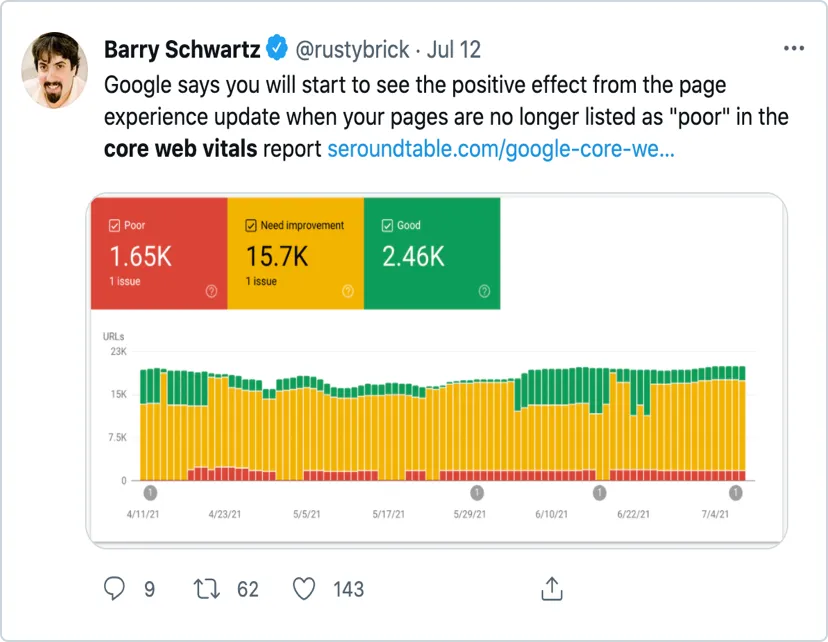
Boosts in Rankings from Core Web Vitals
Google representative, John Mueller, says that you'll start seeing small increases in rankings from the Page Experience update when your site begins to score in the "Needs Improvement" or "Good" categories of the Google Search Console core web vitals report. Of course, CWVs are not a silver bullet. CWVs are just one of many ranking factors.
In this article you’ll learn:
- History of the Page Speed Ranking Factor
- How the Page Speed Ranking Factor will expand in 2021
- What are Core Web Vitals?
- What does this algorithm update mean for SEO?
- What does this algorithm update mean for conversions and revenue?
- How to measure Core Web Vitals
- How to improve Core Web Vitals
- The future of Core Web Vitals
- The latest news about Core Web Vitals
- Frequently Asked Questions About The Page Experience Update
Improving your page speed will have the greatest impact on the 2021 Page Experience update:

Boost Your Speed Score 20-40 Points
The history of the Page Speed ranking factor
Google updates its search engine ranking algorithm thousands of times per year. Most of the changes are minor and go unnoticed without much industry chatter. However, since the inception of its search engine and PageRank algorithm in the late 90s, Google has publicly announced numerous core (read: major) updates to its algorithm, many of which were geared towards recognizing and penalizing spam and sites trying to cheat the system, like the Panda update in 2011, the Penguin update in 2012, and the Medic core update in 2018. This past year (2020), Google launched three broad core algorithm updates and this year (2021), Google has made fairly significant updates to the algorithm seven times. The most recent update was the broad core update on July 22nd.

Some of these updates have also focused on improving the user experience as it relates to site speed. Operation “speed up the internet,” for example, has been underway since 2010 when Google announced the desktop site-landing speed would be a new ranking factor for search results. In 2018, they doubled down, announcing to the search community that mobile site-loading speed would also become a ranking factor as well.
Since these algorithm updates have gone live, metrics associated with page speed have only become more important. Users increasingly expect a stellar page experience as they navigate the internet and purchase products and services from websites — especially from mobile sites. And in many ways, the importance of a quality user experience has transcended the realm of SEO — it influences all marketing channels now.
In the context of site speed, user experience has always been difficult to capture in a single metric. It certainly hasn’t been satisfactorily accounted for in previous updates. This Core Web Vitals quality update is the product of extensive research on user behavior, which determined that the best proxy for a quality user experience was to measure how quickly the most important content loads on page (largest contentful paint), how fast buttons and such respond to a user click (first input delay), and how little the page moves as additional elements load (cumulative layout shift).
How the Page Speed ranking factor will expand in June 2021
In May 2020, Google announced the planned launch of a broad core algorithm update, called the “page experience” update, in the spring of 2021 that would be focused on measuring the quality of a web page’s user experience. The update was announced over a year in advance to give webmasters a sufficient timeline to improve their sites before the new ranking factors went live.
Originally, the update was supposed to go live in May 2021. However, Google announced on April 19th, 2021 that the rollout wouldn’t begin until June 2021, and that it would be granular at first before fully having an impact on rankings by the end of August 2021. They related the rollout to the gradual flavoring of food saying, “You can think of it as if you’re adding a flavoring to the food you’re preparing. Rather than add the flavor all at once into the mix, we’ll be slowly adding it over this time period.”
What Are the Google Core Web Vitals
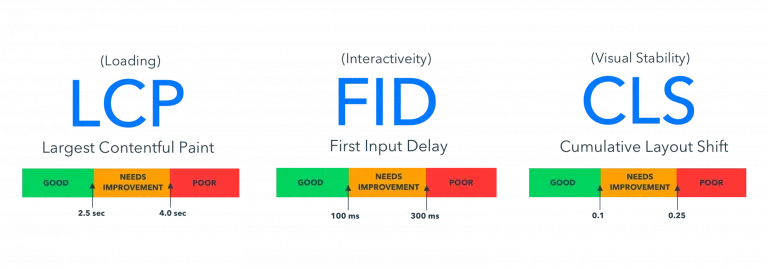
Core Web Vitals are a new set of user experience-based ranking signals that make up Google’s “page experience” update, which goes live in June 2021. They measure various real-world user experiences with your site that determine your overall page speed and page performance scores, and will ultimately have some impact on your page rankings in search results.
Largest Contentful Paint

The first Core Web Vital, Largest Contentful Paint, essentially measures how quickly the largest and most important piece of page content loads in the initial viewport for a user visiting the site. To pass a Core Web Vitals assessment, this piece of content needs to load in under 2.5 seconds. It also accounts for 25% of your Google Performance Score. You can read more about the details here.

First Input Delay (FID)
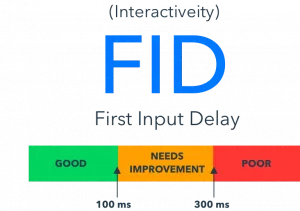
The second Core Web Vital, First Input Delay, measures how responsive your web page is to user input, like the clicking of a button. To pass a Core Web Vitals assessment, your web page needs to register a response time under 100 milliseconds. It also accounts for 25% of your Google Performance Score. You can read more about the details here.


John Mueller Explains FID
John has a good point here. If you click into a site and it appears to load a little slow, you might be okay with it. But, if a page has already loaded and then you can't interact with it... you're likely going to leave the page. That's a really bad page experience, so Google wants to avoid serving those web pages to search engine users if they can.
It's also important to point out the connection here between FID and bounce rate. When a user goes to click and something and the page doesn't respond it's bad for your business. That user will be more likely to bounce, they won't convert, and the bad page experience can reflect poorly on your brand.
Cumulative Layout Shift

The third Core Web Vital, Cumulative Layout Shift, measures the stability of your web page and whether elements move out of place as additional ones are loaded. To pass a Core Web Vitals assessment, your web page needs to register a score under .1. It also accounts for 5% of your Google Performance Score. You can read more about the details here.
To pass a Core Web Vital assessment and receive a ranking boost, your page needs to register a passing score for each of these metrics. Additionally, each of these three metrics will be considered alongside pre-existing page experience metrics that include being mobile-friendly, safe-browsing, HTTPS, and having no intrusive interstitials.


John Mueller Explains Cumulative Layout Shift
"Ugh. Bye" is right. No user wants to put up with a shifty, unstable page. They will simply leave. So, again, a page that with a low CLS score is likely to have a higher bounce-rate, lower conversion rate, and reflect poorly on your brand.
How will the new Core Web Vitals and page experience update impact your SEO?
From an SEO standpoint, there will be an incentive to optimize your website for good Core Web Vitals scores because they will become a lightweight ranking factor. And Google plans to show a badge alongside specific search results that pass the Core Web Vitals assessment, in order to signal to users that they can expect a good experience on these pages. Additionally, a good user experience improves bounce rates, conversion rates, and ultimately, revenue, across all marketing channels.
That said, you don’t want to abandon quality content creation efforts in the process of optimizing for this update. As Google’s Martin Splitt said:
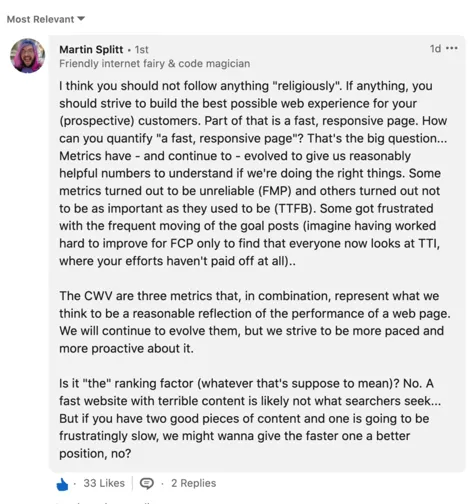
Should we follow these metrics 'religiously'?
Simply put, you still need to provide valuable content to your users that answer their questions, and you still need to consider the other ranking factors. However, if you aren’t thinking about user experience in terms of page performance then you simply are not providing the highest value to your audience, and your Google Search rankings will reflect that.
How will Core Web Vitals and the page experience update impact conversions and revenue?
If your website isn’t currently meeting the aforementioned criteria for good page experience, then it’s already hurting your conversions and revenue — not just in organic search — but across all marketing channels. There are lots of studies on this from Google and industry research that indicate the correlation between good user experience and conversions. For example:
- Pages that loaded in 2.4 seconds had a 1.9% conversion rate
- At 3.3 seconds, conversion rate was 1.5%
- At 4.2 seconds, conversion rate was less than 1%
- At 5.7+ seconds, conversion rate was 0.6%
Longer page load times have a severe effect on bounce rates. For example:
- If page load time increases from 1 second to 3 seconds, bounce rate increases 32%
- If page load time increases from 1 second to 6 seconds, bounce rate increases by 106%
For the relationship between first contentful paint and revenue:
- On mobile, per session, users who experienced fast rendering times bring 75% more revenue than average and 327% more revenue than slow.
- On desktop, per session, users who experienced fast rendering times bring 212% more revenue than average and 572% more revenue than slow (ALDO Case Study).
Here's a comment from Google on the reason for this page experience update:
This page experience update will make it even harder for sites with poor user experience to rank highly and get traffic from the search results that matter most to their businesses. As previously mentioned, Google will be adding a badge directly in search results to sites with good user experience, so it will be interesting to see how users respond and whether they will be more likely to bypass or ignore sites without this endorsement altogether.
How do you measure the Core Web Vitals?
You can monitor and measure Core Web Vitals data in three different places: the Google Page Speed Insights Tools, the Google Lighthouse Report, and in the Google Search Console Page Experience Report. Drilling down further, you can look at field data (looking at real-world user experiences) and lab data (looking at controlled environments with predetermined network and device settings) separately.
Google Search Console Page Experience Report
For example, the Google Search Console Page Experience Report shows how your pages are performing across all 7 metrics (in addition to the Core Web Vitals) based on field data from the Chrome User Experience Report. By contrast, the Google Lighthouse Report shows performance data that comes from the lab. The Google PageSpeed Insights Tool is capable of showing both field and lab data, as well as an overarching page speed “score” on both desktop and mobile devices.
Google PageSpeed Insights Tool
To see whether you are passing or failing the Core Web Vitals assessment in the Page Speed Insights tool, simply go to this URL, input your URL, and results will be returned that show scores for each of the individual Core Web Vitals and whether your site is passing the assessment, based on data collecting in aggregate over the previous 28 days.
Google Lighthouse Report
To see your Core Web Vitals scores in Google Lighthouse, open up a URL from your website on a Chrome browser, right-click on the window and click “inspect”, then click on “Lighthouse” and “Generate Report” in the window that opens on the right-hand rail. Click on the performance score and it will open up a window displaying numbers for each of the Core Web Vitals, as well as links to how each is calculated.
The overall page experience and Core Web Vitals report in Search Console can be accessed via the left handrail in Search Console nested under “Experience.” These will show the percentage of URLs on your site with a “good” page experience, as well as URLs that are “in need of improvement” or “poor” and what the specific details are.
How do you improve Core Web Vitals scores?
It should be noted that improving your Core Web Vitals requires technical chops. If you are not a developer yourself, consider assigning responsibility for these scores to a developer on your team, outsourcing the work to SEO experts, or using software designed to improve these metrics.
The first thing you should do is understand the problems specific to your site. Perhaps, for example, your site is scoring well on Cumulative Layout Shift, but you have a lot of room for improvement on First Input Delay and Largest Contentful Paint. Run a quick audit of your site through Page Speed Insights or Lighthouse to see where you stand on all three and what strategies are suggested for improvement, and then dive into the Core Web Vitals report in Search Console to see which specific URLs need to be fixed.
If you are scoring in the “green” on all three metrics and therefore passing the Core Web Vitals assessment, simply continue to monitor these numbers on a weekly basis in the leadup to the update. Unless you are reliant on software, achieving good page speed is not usually a “set it and forget it” type endeavor. It requires vigilance.
If you are scoring in the “orange” or “red” on any of the three metrics and therefore failing the Core Web Vitals assessment, dive into the recommended suggestions for improving each score and open up that Core Web Vitals report to identify which URLs need to be fixed.Of course, you could simply use Huckabuy Page Speed software to solve the problem. That said, in future articles, we will detail exactly how to improve Largest Contentful Paint, First Input Delay, and Cumulative Layout Shift scores if you want to approach this problem with developer time and resources.
The Future of Core Web Vitals
While the Core Web Vitals include the three metrics we've discussed in 2021, that does not mean the Core Web Vital Metrics will not change in the future. The point of the Core Web Vitals is to ensure that websites are providing a quality page experience to users. If, for example, Google determines the cumulative layout shift is not actually that important to overall page experience for users, then they could get rid of the metric in the future. They also could add new metrics.
Huckabuy Page Speed Software and the Core Web Vitals
The New Google Algorithm Update has everything to do with page speed. Watch this video to learn what's changing and find your solution.
Hello everyone, Ryan from Huckabuy here and today we are going to be talking about the recent/not-so-recent Google announcement of their core algorithm update that's going to be happening in two weeks.
0:20
Now, to preface this — and this shows how important it is — rarely does Google actually announced that they're going to have an algorithm update, but they did for this, simply because they wanted to give webmasters, time to make the needed adjustments to their websites, so that they could prepare and be ready for when this big algorithm update hits. With that being said, let's get into what the algorithm change actually is and what it's about.
The first thing in this video we're going to be talking about is what page speed looks like as a ranking factor currently, and what it's going to look like as a ranking factor in 2021. We'll answer "What are the 2021 Core Vitals?" Then, we're going to be looking at how to measure those Core Vitals, what that algorithm update means for SEO, and how the Page Speed of your site — which is what this algorithm is all about — affects your conversions and revenue. And then last but not least, and probably the most important, we'll talk about how to actually adjust those Core Vitals that are going to be affected by this algorithm update.
We're talking about algorithm updates here, and back in 2010, Google announced that they were absolutely — and this is a quote — "obsessed with speed." So, they double down on that by actually making it a ranking factor for mobile in 2018. So, if your website was super slow, chances are would probably hurt your SEO and your rankings. Now, they're even doubling down more with this new algorithm update that's solely focused — well, not solely focused but primarily focused — on how fast your website runs, and the user experience that comes with that speed, and how fast it actually loads.
2:25
What are the Core Web Vitals and Page Experience Signals that Google is really focusing on? They are mobile-friendliness, Safe Browsing (HTTPS) — that's obviously having a secure website, and no intrusive interstitials. An interstitial if — if you don't know what that means — is simply something like a pop-up ad on your website. Now, if you have a pop-up where it's just requesting the user enter their email for a download or something like that's what a user would normally expect. But these ads that pop up or these interstitials that are intrusive and interrupt that browsing experience, chances are you won't necessarily get penalized for it, but it's not going to help you rank.
Then, we're going to deal with the largest contentful paint, the first input delay, and what we call cumulative layout shift. LCP, or largest contentful paint, FID, first input delay, and cumulative layout shift, CLS. Keep those acronyms in mind if you're someone in the SEO community, webmaster, or something like that. Learn those acronyms. They're something new for the whole SEO industry.One of the things that you can do to actually measure those core vitals is to get into what we use as a specific tool — it's called Google PageSpeed Insights. Let's take a look at Huckabuy's website, or actually not Huckabuy, but Vivint's website. Vivint sells well-known security cameras Home Alarm System, Home Automation, and things like that. Here we have what we call the "core web vitals," largest contentful paint, first input delay and cumulative layout shift, and First Contentful Paint. So those are the ones that you need to focus on if they're longer than a certain specific timeframe. If they take that long — that's going to actually really reduce the ranking of your website, due to it not loading fast enough.
4:21
What is first contentful paint (FCP)?
That's actually really easy to explain. It's that time from when someone actually hits the button to go to your website or clicks on a link or something like that, to the time that it actually shows something from that specific page whether it be an image or text or something to indicate that that page is actually loading on whatever device that you're trying to view it from — whether it's a PC, tablet or phone. So, first content paint does that really matter? Yes, it does. You want that number — that time — to get as low as possible.
Looking at the largest contentful paint, what are the timeframes that you need to kind of focus on for this one? Largest contentful paint, as opposed to first contentful paint, measures when page to page navigation is actually showing for a user — when it appears fully complete. And that's within the navigation of that website. So, more technically LCP measures the render time of the largest image or text block visible within that specific viewport or device.
5:44
The numbers that you want for the largest Contentful paint? You want it under 2.5 seconds. Anything between 2.5 and 4.0 you really need to improve and then anything over four seconds is really, really bad.
6:00
That's FCP and LCP. Now, let's look at FID, first input delay. This is fairly simple as well. If you have a webpage on your cell phone, and you tap on it, how long does it take from that tap to get to where it's pointing? That's what first input delay is. When it's actually just a delay of when that user inputs something, whether it's a mouse click or a tap on a cell phone. Another example of that is if it appears that a web page is actually done loading, but nothing is responsive when you actually click on it. That means that that page has a really really high. First, input delay.You want the input delay to be under 100 milliseconds for around three-quarters of your web pages — or 75% of your website — and this number applies to all of these other metrics, whether it's cumulative layout shift, first input delay, or first contentful paint. The majority of your website needs to be very very very fast — at least three quarters or 75%.
7:05
So, under 100 milliseconds for first input delay, that's good. Over 300 milliseconds, you'll probably want to indicate to someone that it needs to be fixed.
7:18
Moving on to cumulative layout shift. Well, the best way to understand that is. Think of it as a metric that measures visual stability. When a webpage is loading, sometimes it'll appear that the page is finished loading to any specific user. But when that user clicks a button and an ad pops up where they were supposed to click, then that's what your cumulative layout shift is. When your entire site is loading, and in that process of loading someone taps on it, and they miss-tap or it directs them somewhere else where they didn't really intend to go — that's from cumulatively layout shift. You want that under 0.1. If it's high, you'll score 0.25, and you really don't want to be much higher than that.
8:17
Alright, so those are the new core web vitals and the target metrics for your website. Keep in mind, three-quarters of it should be passing core web vitals.
8:29
What do the core web vitals mean for Google Search Results?
At the beginning of the video, I mentioned that this is a really, really important algorithm update because Google not only announced it [they didn't with previous core updates], but they want to give webmasters time to fix it. So how important is this really [for SEO]? We already know that Page Speed is a ranking factor, this is going to be more of a ranking factor. It's really really high up there on the ranking scale simply because it affects the usability of the website. Is it the only thing that you should be doing? Not necessarily, you still need to focus on meaningful content. Martin Splitt, a developer over at Google, was asked this question, basically, 'Is this THE thing to do for SEO?' He said absolutely not, you really want meaningful content on there because if Google goes in and says 'hey, you have a fast website but your content is crap and it's not engaging.' Yeah, you're not going to rank for it so this (load speed) is just something to focus more on.
9:26
What do the core web vitals mean for business revenue?
I mentioned at the beginning of the video that we're going to talk about how site speed actually affects conversions and revenue. So let's take a couple of numbers from some recent studies and if you're on this article we have links to these studies as well. So feel free to go visit those. This is from a case study that has been completed. So pages that load in 2.4 seconds, on average, had a 1.9% conversion rate. That's actually pretty good. It does drop below that when you're looking at 3.3 seconds where the conversion rate was 1.5%. There's only a 0.4% difference there so not that bad. But when you get into like 4.2 seconds, the conversion rate tanks. It goes less than 1%, and then at 5.7 seconds, it goes 0.0-0.6%. So you can see how the speed actually does affect those. Really interesting case study, too. I'll pull out a couple more details and we'll talk about those here as well.
10:28
Longer page load times have a severe effect on bounce rates. Well, you kind of know that. If it's not engaging to the customer, they're just going to bounce right out of there.
10:40
Some of those metrics are if page load time increases from just, say like, 1-3 seconds. Your bounce rate will increase over 30-32% to be exact. If your page load time doubles that and increases from 1 to 6 seconds, your bounce rate actually increases by 106%. Those are some big numbers there. So, this is where page speed actually comes into play and especially if you're looking at increasing revenue, or even fixing [site performance] — decreasing your bounce rate or your page load speed.
Now, there is a relationship between first Contentful paint and revenue. So that being said, on mobile per session users who experience fast rendering times bring 75% more revenue than the average page load time. And then even 127% more than what a slow page would be. So, if your site is faster than average, you're gonna have 75% revenue. If you're faster than slow (ie, average), you're gonna have 327% more revenue, and this is just between the first Contentful paint that's the first thing that the user sees when they go to your website. So you can potentially see how that would actually hurt your business.
How do you actually improve those Core Web Vitals? Well first off, you have to have to identify them. You identify them by using either PageSpeed Insights or Google Search Console. If you haven't connected your website to Google Search Console that's going to be the main key because they have Core Web Vitals. The Core Web Vitals Report in Search Console will really show you in-depth information on each specific page. What you need to work on whether it's largest contentful paint, or first contentful paint anything on those lines. Again, make sure that your website is linked up to Search Console so you can start tracking those. You can also use PageSpeed Insights and load that. One thing to know with PageSpeed Insights [and Search Console] is that it's a rolling 30 day period. So if you make a change on your website, it's not going to be reflected in PageSpeed Insights for at least 28-30 days, somewhere in there. It's better to run that on, say, a local computer and do a Page Speed Test locally [with Google Lighouse].
13:09
Once you've identified the page experience problems, how do you fix those?
13:14
Well, that's where a developer comes in. If you have a developer come in, they're going to be able to do that but they're only going to be able to do that page by page. So if you have a really, really large website that's going to take a lot of time, and if you haven't started on it now, it's probably a good thing that you do.
The other thing is — obviously since this is a video for Huckabuy — Huckabuy has a PageSpeed software that can take care of those speed issues, right off the bat. It'll handle every web page. In fact, if you want, you can actually assign a specific problematic area of your website and just have our software target that problematic area.
14:00
So that being said, those core vitals and that's Google core update.
If you have any other questions you can reach us through Huckabuy.com at the Contact Us page or book a demo. Thanks for watching. We'll see you soon.
The Latest on Twitter about the Core Web Vitals
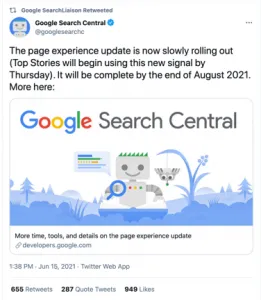
Google Announces June 2021 Core Update Live
On June 15th, @GoogleSearchCentral tweeted that they are beginning the new Page Experience update rollout and will complete the rollout in August 2021.
Google also announced the June 2021 broad core update release on June 2nd with plans to release a July 2021 core update. These are core updates unrelated to the Page Experience updates.

SEO Expert Aleyda Solis Talks CWV
Aleyda Solis has been one of the many voices talking about site speed, Page Experience, and the new Core Web Vitals. She reminds us that while Page Experience signals will affect SEO, prioritizing site performance is first and foremost about the user.
Google has proven that users care about site performance more than any other user experience category.
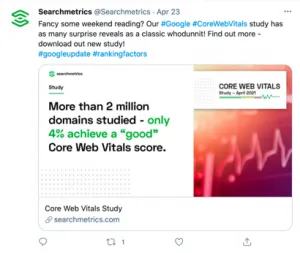
Study finds only 4% of sites score "good" on Core Web Vitals
A study conducted in April 2021 by Searchmetrics revealed that only 4% out of 2 million domains were passing all of the Core Web Vitals.
FREQUENTLY ASKED QUESTIONS
What is a Google Algorithm update?
A Google algorithm update is a change made to Google’s search engine in order to improve the quality, relevance, and overall user experience of its search results.
What is a Google “core” Algorithm update?
A core algorithm update is one that is so significant to the algorithm, that Google is compelled to publicly announce the pending changes, usually well ahead of time to give webmasters sufficient time and opportunity to adjust. The June 2021 “Page Experience” update is an example of a “core” algorithm update.
How often does the Google algorithm change?
Google updates its algorithm quite often. Sometimes thousands of times per year. But most of these changes go unnoticed. Typically, when a significant change is made, Google makes a public announcement well ahead of time.
What is the latest upcoming Google algorithm update?
The latest (publicly acknowledged) algorithm update is the “Page Experience” update, which introduced new ranking factors tied to the quality of a site’s user experience (loading speed, responsiveness, and visual stability). The rollout for this update began in mid-June 2021 and is expected to be complete by the end of the summer.
What is the Google “Core Web Vitals” update?
The Google Core Web Vitals update is a core algorithm update that began to roll out on June 16th, 2021. It will introduce three new metrics into the algorithm that measure and help rank sites based on the quality of their user experience. Specifically, they look at how quickly the largest piece of content in the initial viewport loads, how responsive the page is, and how visually stable the page is. The three metrics that make up the Core Web Vitals are called Largest Contentful Paint, First Input Delay, and Cumulative Layout Shift.
Why are Core Web Vitals important?
Core Web Vitals are important primarily because they are set to become a new ranking factor in Google’s search algorithm in 2021. They are also important because they measure the quality of a site’s user experience, which is important for all marketing channels and has a big impact on key metrics like bounce rates, conversions rate, and revenue.
How do you pass the Core Web Vitals assessment?
In order to pass a Core Web Vitals assessment, your web page must receive a passing score for each of the metrics. For the Largest Contentful Paint, you must be under 2.5 seconds. For First Input Delay, you must be under 100 milliseconds. And for Cumulative Layout Shift, you must be under 0.1.
How do you measure for Core Web Vitals?
There are numerous tools and reports that can be used to monitor and measure your website’s Core Web Vitals. We recommend using any of the following: Google’s PageSpeed Insights tool, and both the Core Web Vitals and Page Experience reports in Google Search Console. All three of these tools use real-world user data to collect information about the experience your site provides to users over about a 30 day period. In order to troubleshoot fixes to your website for Core Web Vitals, we recommend using Google Lighthouse. This tool gives you an estimate of how your web page will perform for the average user by using a controlled testing environment.
Top Articles
History of Google Algorithm Updates
01 / 13 / 2021
Google’s algorithm has a massive impact. Google Search is such a prominent resource in answering questions for so many people and many businesses, organizations, and creators optimize their web content for Google search engine users. That’s why it’s so important that Google is continually adapting and improving its algorithm.
. . .
Introduction to First Input Delay for SEO
12 / 19 / 2020
First input delay (FID) is a key metric in Google’s new set of “Core Web Vitals” that measures the delay in discrete event processing (like the click of a button) in order to capture a user’s first impression of a site’s interactivity and responsiveness. In other words, FID measures the experience users feel when trying to interact
. . .
Introduction to Cumulative Layout Shift for SEO
12 / 05 / 2020
Cumulative layout shift is a key metric in Google's new set of “Core Web Vitals” that measures the sum total of all the unexpected layout shifts that occur during the loading of a page. A layout shift occurs any time a visible element changes position from one frame to the next. To illustrate, say you went to click on
. . .
Core Web Vitals
12 / 01 / 2021
The Core Web Vitals are all about site performance, and improving Core Web Vitals can be difficult. That's why we built Huckabuy Cloud — to give all types of businesses peace of mind when it comes to addressing technical SEO issues like site performance.
Our software leverages Google’s latest technical SEO initiatives to solve for the most important Core Web Vitals - largest contentful paint and first input delay.
. . .